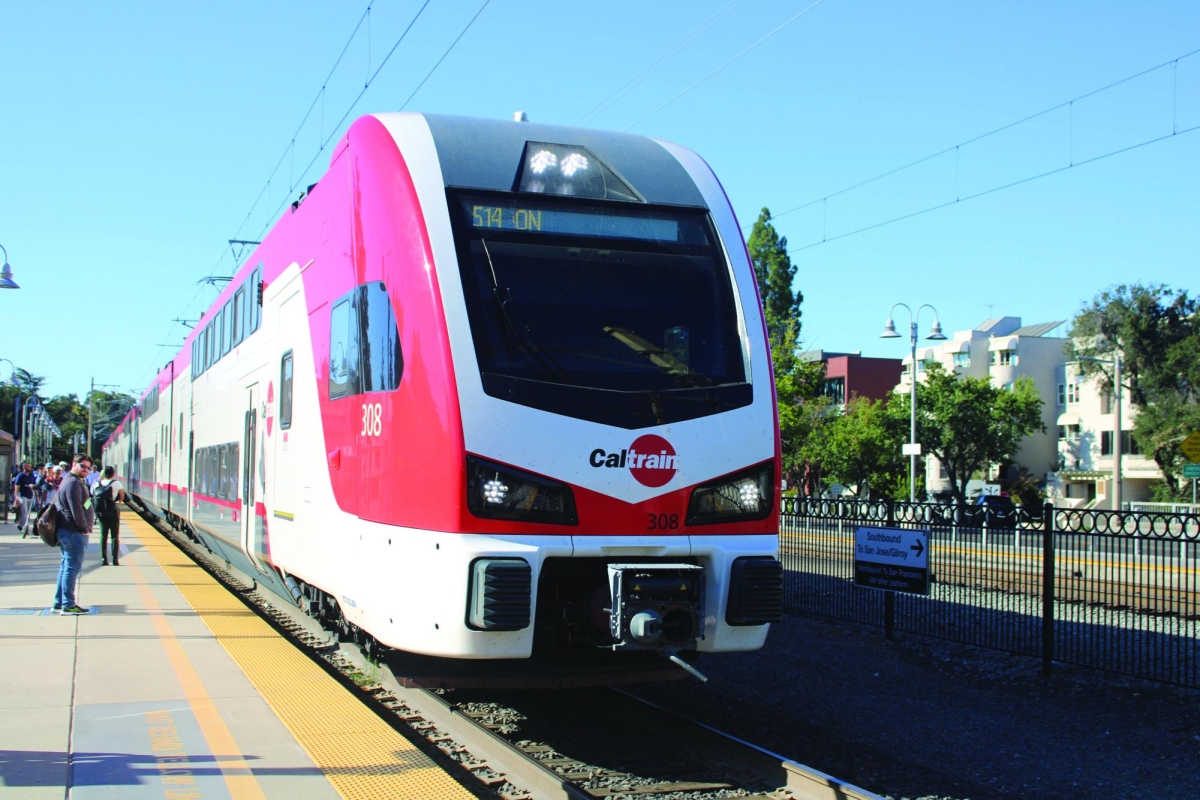Palo Alto High School history teacher Kenneth Tinsley used to wait as the train passed by his classroom, putting his class on hold from the noise produced by the train.
“I’d be talking, and then I’d stop and wait for the train to pass, because … look at that, right there,” Tinsley said, gesturing at a passing by train.
This was a common occurrence for teachers whose classrooms were near the train tracks. But now, Tinsley said he doesn’t worry when the trains pass by — his classroom is much quieter.
This newfound quiet teaching environment is a result of Caltrain’s new fleet of electric engine powered trains, which have replaced the old diesel ones. The trains have been eagerly awaited.
“I’m just hearing the metal gliding along the tracks, I’m not hearing the engine,” Tinsley said. “They’re so much quieter than what we had with the diesel engine.”
On Aug. 11, Caltrain launched the new trains, replacing most of the diesel powered trains that were previously in use. According to the Caltrain website, these new trains are faster, feature better onboard amenities and are quieter than their predecessors.
Paly junior Tarika Pillay said the new trains are much superior to the old models.
“The new ones [trains] are really clean, they’re modern looking and much quieter and quicker,” Pillay said. “I went all the way to San Francisco on a new electric train, and it was … a good experience, it was quick and efficient.”
These new trains were the result of the Caltrain Electrification project, which started July 2017 and was completed in April of this year. It costed upwards of $2 billion.
Dan Lieberman, public information officer for the San Mateo County Transit District, said it was time for the train to be updated.
“Our riders needed a more modernized system,” Lieberman said. “Our old fleet was, well, the old fleet, and it was due for an overhaul.”
Tinsley agrees with this sentiment.
“You don’t want to be riding in a 40 year old [train] car, right?” He said.
Other reasons for introducing the new electrified fleet include the environmental benefits and small upgrades, like free on-board Wi-Fi, charging stations and nicer bathrooms.
However, according to Lieberman, the biggest change is the increased frequency of the trains. On Sept. 21, Caltrain implemented a new schedule, increasing how often the trains run.
“If you look at pretty much any survey of transit users in any system in the world, … they want increased frequency and increased reliability,” Lieberman said. “Under the new schedule that launches on … [Sept.] 21 we’re going to be seeing trains every half hour on weekends up from every hour.”
Pillay said she thinks that the increased frequency of the trains is a valuable improvement.
“It’s really annoying if you [want to] go somewhere, and the next train is coming in like an hour,” Pillay said, “It doesn’t feel like you have to wait forever to use the train, and it’s much more convenient.”
While updating the infrastructure went smoothly for the most part, it still had some challenges.
“Construction for this project took place on a live rail yard, a 51-mile rail corridor that actively had trains moving through it the whole time … it’s a real logistical challenge,” Lieberman said. “Construction is complicated work in and of itself. When you add a train going through the work site on a semi-regular basis, that really bumps that up.”
In the future, the Peninsula Corridor Joint Powers Board, which is in charge of Caltrain, hopes to expand the electrification project to the southernmost parts of Caltrain, down to Gilroy. Overall, the Caltrain Electrification Project has been met with a positive response from passengers, including Tinsley, who takes the train to school.
“Considering we haven’t done an improvement to Caltrain since the ‘90s, I would say that’s probably good money spent,” Tinsley said.
Lieberman concurs.
“Everyone seems really happy with what they say,” Lieberman said. “Now that we’re on the other side of it … well, it’s hard to look at it and say that it wasn’t all worth it.”
What’s Coming Next
The electrification project isn’t the end of the upgrades that are coming to Caltrain. According to the High Speed Rail Alliance, the improved infrastructure built during the project is also going to be used for California High Speed Rail, the high speed rail project that will connect most of California. It has not begun construction yet in the Bay Area.
Additionally, the City of Palo Alto has been considering renovating the Churchill Ave. train crossing. They have looked at closing Churchill entirely and adding a pedestrian underpass, or creating a partial underpass while keeping Churchill open, and raising Caltrain above the crossing entirely.



